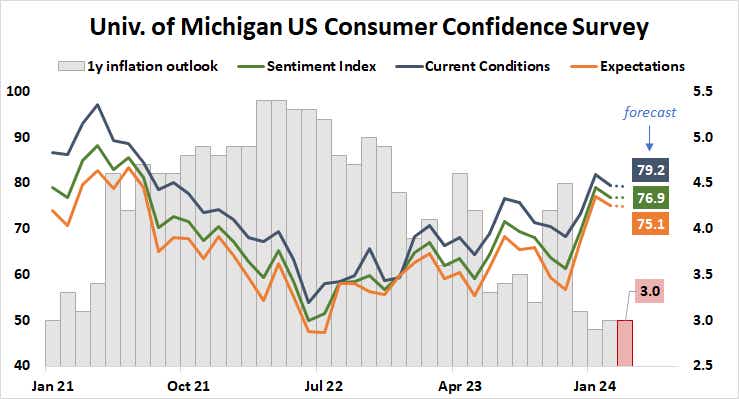Stock and Bond Markets at Risk as Fed Rate Cut Expectations Fizzle

Stock and Bond Markets at Risk as Fed Rate Cut Expectations Fizzle
By:Ilya Spivak
Stock and bond markets are at risk as economic data erodes Fed rate cut expectations. A report on U.S. consumer confidence is in focus next.
- Hotter-than-expected U.S. PPI data spooked Wall Street and lifted Treasury yields.
- U.S. consumer confidence data may push back on Fed rate cut outlook further.
- If the priced-in policy view moves to -61 bps or higher, risk appetite may fizzle.
Two hotter-than-expected U.S. inflation data points were apparently a bridge too far for stock markets. Wall Street took in stride the overshoot on consumer price index (CPI) data released this week, but more of the same from the producer price index (PPI) was met with jeers.
The headline wholesale inflation rate printed at 1.6% year-on-year in February, marking a potent jump from the 1% recorded in the prior month. The outcome sailed well past economists’ forecasts penciling in 1.1% ahead of the release. Core PPI excluding food, energy and trade rose 2.8%, the highest since October.
The bellwether S&P 500 as well as the tech-tilted Nasdaq turned lower, though the small-cap Russell 2000 was the standout loser. It is on pace to close with a loss of nearly 2.5%. Treasury yields surged across maturities while rates-sensitive gold and the Japanese yen fell. Bitcoin lost 4.5%.
Fed rate cut expectations are diminishing
Perhaps most critically, the outlook for Federal Reserve monetary policy shifted to the least dovish setting in two weeks. Fed Funds futures now price in 67 basis points (bps) in cuts in 2024. That moves markers further away from the 80-bps baseline that the central bank established in December, and in the wrong direction for risk appetite.

From here, the spotlight turns to the closely watched measure of U.S. consumer confidence from the University of Michigan (UofM). The mood soured a bit in February as one-year inflation expectations ticked up from 2.9% to 3%. Incoming figures are expected to register broadly unchanged for March.
February’s U.S. retail sales data fell short of expectations. Receipts posted a monthly rise of 0.6%, trailing estimates anticipating 0.8%. January’s reading was also revised lower to a decline of -1.1% from -0.8%. Taken together with warmer CPI and PPI readings, this might foreshadow disappointment on UofM results.
Stocks and bonds at risk on consumer confidence report
If the survey shows sentiment continued to deteriorate while the inflation outlook ticked higher, the markets may reason that the argument for Fed easing has weakened further. As it stands, two 25 bps cuts are fully priced in and the probability of a third cut still stands at a better-than-even 67%.
Moving the priced-in outlook to -61 bps or higher would signal that markets have shifted to imply that two cuts are likelier than three. That would put the markets on the hawkish side of the Fed’s baseline. This might amount to a headwind for stocks and bonds alike, while yields and the U.S. dollar trek upward.

Ilya Spivak, tastylive head of global macro, has 15 years of experience in trading strategy, and he specializes in identifying thematic moves in currencies, commodities, interest rates and equities. He hosts Macro Money and co-hosts Overtime, Monday-Thursday. @Ilyaspivak
For live daily programming, market news and commentary, visit tastylive or the YouTube channels tastylive (for options traders), and tastyliveTrending for stocks, futures, forex & macro.
Trade with a better broker, open a tastytrade account today. tastylive, Inc. and tastytrade, Inc. are separate but affiliated companies.
Options involve risk and are not suitable for all investors. Please read Characteristics and Risks of Standardized Options before deciding to invest in options.
tastylive content is created, produced, and provided solely by tastylive, Inc. (“tastylive”) and is for informational and educational purposes only. It is not, nor is it intended to be, trading or investment advice or a recommendation that any security, futures contract, digital asset, other product, transaction, or investment strategy is suitable for any person. Trading securities, futures products, and digital assets involve risk and may result in a loss greater than the original amount invested. tastylive, through its content, financial programming or otherwise, does not provide investment or financial advice or make investment recommendations. Investment information provided may not be appropriate for all investors and is provided without respect to individual investor financial sophistication, financial situation, investing time horizon or risk tolerance. tastylive is not in the business of transacting securities trades, nor does it direct client commodity accounts or give commodity trading advice tailored to any particular client’s situation or investment objectives. Supporting documentation for any claims (including claims made on behalf of options programs), comparisons, statistics, or other technical data, if applicable, will be supplied upon request. tastylive is not a licensed financial adviser, registered investment adviser, or a registered broker-dealer. Options, futures, and futures options are not suitable for all investors. Prior to trading securities, options, futures, or futures options, please read the applicable risk disclosures, including, but not limited to, the Characteristics and Risks of Standardized Options Disclosure and the Futures and Exchange-Traded Options Risk Disclosure found on tastytrade.com/disclosures.
tastytrade, Inc. ("tastytrade”) is a registered broker-dealer and member of FINRA, NFA, and SIPC. tastytrade was previously known as tastyworks, Inc. (“tastyworks”). tastytrade offers self-directed brokerage accounts to its customers. tastytrade does not give financial or trading advice, nor does it make investment recommendations. You alone are responsible for making your investment and trading decisions and for evaluating the merits and risks associated with the use of tastytrade’s systems, services or products. tastytrade is a wholly-owned subsidiary of tastylive, Inc.
tastytrade has entered into a Marketing Agreement with tastylive (“Marketing Agent”) whereby tastytrade pays compensation to Marketing Agent to recommend tastytrade’s brokerage services. The existence of this Marketing Agreement should not be deemed as an endorsement or recommendation of Marketing Agent by tastytrade. tastytrade and Marketing Agent are separate entities with their own products and services. tastylive is the parent company of tastytrade.
tastyfx, LLC (“tastyfx”) is a Commodity Futures Trading Commission (“CFTC”) registered Retail Foreign Exchange Dealer (RFED) and Introducing Broker (IB) and Forex Dealer Member (FDM) of the National Futures Association (“NFA”) (NFA ID 0509630). Leveraged trading in foreign currency or off-exchange products on margin carries significant risk and may not be suitable for all investors. We advise you to carefully consider whether trading is appropriate for you based on your personal circumstances as you may lose more than you invest.
tastycrypto is provided solely by tasty Software Solutions, LLC. tasty Software Solutions, LLC is a separate but affiliate company of tastylive, Inc. Neither tastylive nor any of its affiliates are responsible for the products or services provided by tasty Software Solutions, LLC. Cryptocurrency trading is not suitable for all investors due to the number of risks involved. The value of any cryptocurrency, including digital assets pegged to fiat currency, commodities, or any other asset, may go to zero.
© copyright 2013 - 2025 tastylive, Inc. All Rights Reserved. Applicable portions of the Terms of Use on tastylive.com apply. Reproduction, adaptation, distribution, public display, exhibition for profit, or storage in any electronic storage media in whole or in part is prohibited under penalty of law, provided that you may download tastylive’s podcasts as necessary to view for personal use. tastylive was previously known as tastytrade, Inc. tastylive is a trademark/servicemark owned by tastylive, Inc.